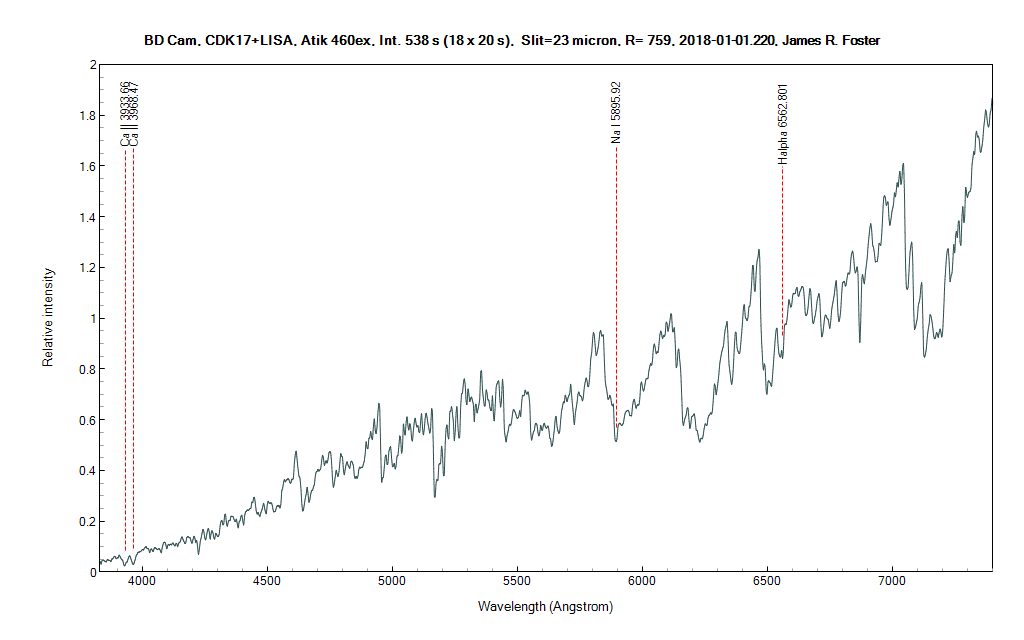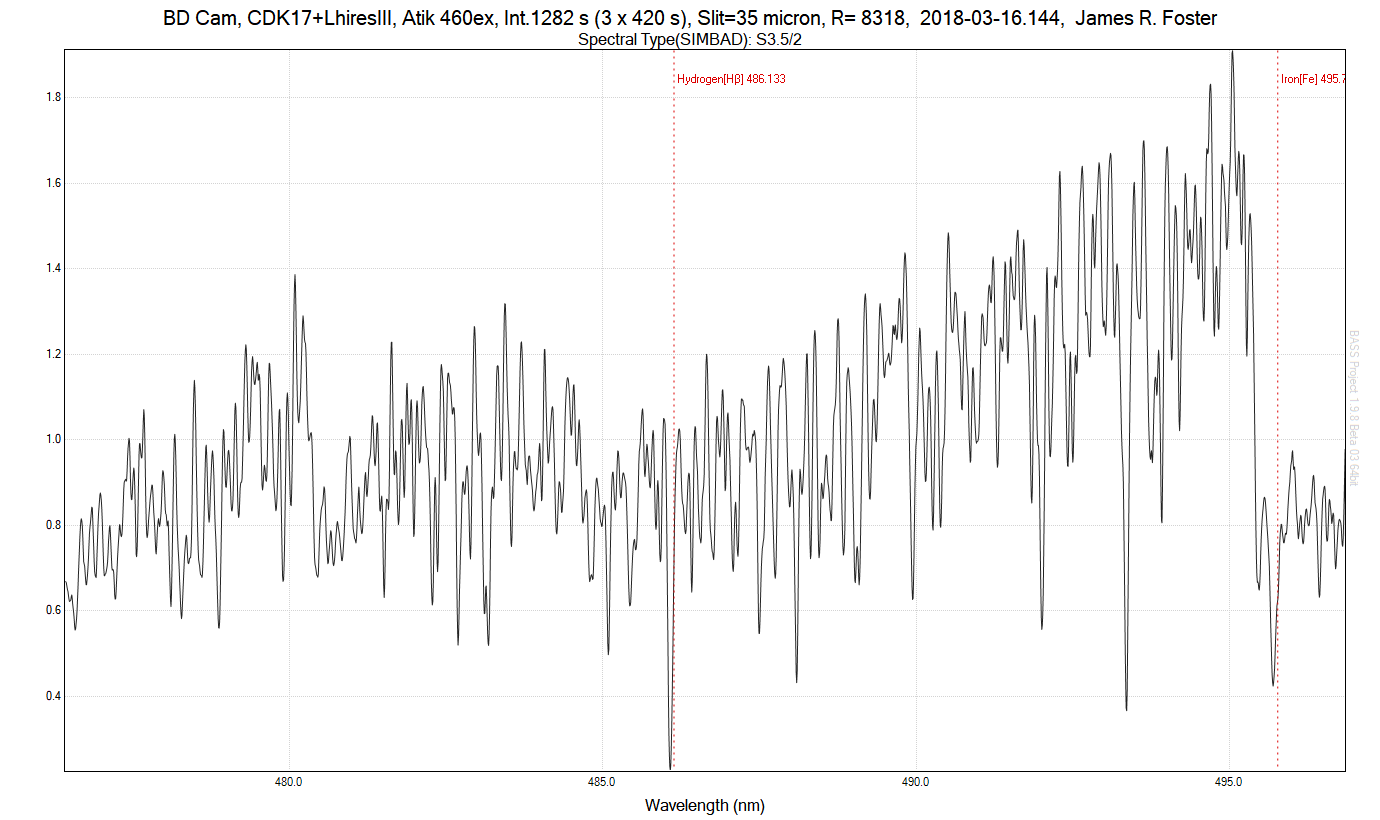Page 1 of 1
BD Cam
Posted: Fri Feb 10, 2017 2:27 pm
by Joan Guarro Flo
Hello :
These observations of the last night of the symbiotic star BD Cam.
Now the bad weather returns.
Regards, Joan.
Re: BD Cam
Posted: Mon Feb 13, 2017 7:19 am
by James Foster
To: Joan
Nice spectra and coincidence with the echelle Mussol, Observatori de Piera.
I might shoot this tomm in the CaK to get a baseline for future observation
because the variability seems constrained to the UV and near IR, He bands.
See:
https://en.wikipedia.org/wiki/BD_Camelopardalis
James Foster
Los Angeles, CA
Re: BD Cam
Posted: Mon Feb 13, 2017 6:28 pm
by Francois Teyssier
Yes, interesting comparison !
Joan, je n'ai pas reçu tes spectres
James,
BD Cam is a low excitation symbiotic
The emission appears only in the far UV 1200-1800
The main interest of BD Cam is ... its brightness.
Scarce observations in low resolution are welcome, because the star can evolves, strenghthening its radiation (intensity and hardness)
Remember that the fascinating CH Cygni has been considered as M giant standart until the 60's when appeared first its emission spectrum
See also SU Lyn (mag 8-9), detected as a symbiotic star recently
Observing any late giant can lead to the discovery of a symbiotic behavior
At higher resolution, it is interesting to compute the radial velocity (orbite)
François
Re: BD Cam
Posted: Mon Feb 13, 2017 9:46 pm
by Joan Guarro Flo
François, te he vuelto a mandar los dos días de observaciones.
Dime si los has recibido, Joan.
Hello James:
My Echelle, Mussol, is designed for the visible spectrum. Possibly could focus a bit on CAK (missing little), but it would be detrimental to the whole of the visible. Moreover, different optical elements and CCD detectors in my power, are focused on the visible spectrum. The result is a set of devices that only open a little door to the ultraviolet. This correspont at the bottom of the image.
At the top we have the infrared, far more generous. Also part childIX approach. Everything depends on the purpose of the observations.
For example, the serious study of Be stars is centered on the H-alpha, so no need to use an Echelle. A normal spectrograph with a resolution from 6000, gives very good results for measurements, like an Echelle.
Other types of stars, symbiotic, WR, New Star. Interesting also areas between 4000 and 5500 angstroms, an Echelle here makes things easier. The other option is to change the angle of the grating in the simple spectrograph. In this sense it seems Echelle le is for people a little lazy.
The infrared can be much more affordable. But for now no one has asked stellar observations the triplet od Calcium (very powerful, between 8500 and 8680 A).
But to observe and monitor planetary atmospheres, not enough with a spectrograph designed expressly for infrared, R=600 or R=1000.
Friendly, Joan.
Re: BD Cam
Posted: Thu Feb 16, 2017 8:59 am
by James Foster
To: Joan & François,
Thanks for the astrophysics (don't think any of our equipment at sea level can get near 1200 A in the deep UV!).
Joan, looks like your using 26 orders out of 34 possible; albeit, the bottom 2 UV(?) rows would be hard to process with low SNR.
If I every move to a darker sky location, get a 0.5 meter or larger telescope, I'll definitively invest in an Echelle system
based on the superb resolution and spectral coverage. Great BD Cam work!
Sincerely Yours,
James Foster
Los Angeles, CA
p.s. About to hit the tutorials for Isis processing with my new LISA spectroscope!
Re: BD Cam
Posted: Sun Dec 31, 2017 10:26 am
by James Foster
Here are some Ha, He5885, Hb, & CaK LhiresIII spectra I've taken recently of BD Cam (23-27Dec17):

Looks like a little flare activity in the CaK region. Note sure if there is any useful info in the spectra centered on the Na doublet region.
This might be my last in awhile.....forcast in Los Angeles calls for rain next few days.......
James
Re: BD Cam
Posted: Wed Jan 03, 2018 1:57 pm
by James Foster
Here is a recent low resolution (LISA) spectrum I took of BD Cam:

Some indications of CaII absorption in this low resolution spectrum as seen from the higher resolution LhiresIII spectra taken on 23Dec17.
Definitely some activity in this interesting symbiotic system!
James
Re: BD Cam
Posted: Wed Mar 21, 2018 8:56 am
by James Foster
Here's recent spectra of BD Cam in Ha & Hb:


Not much to report. I overlayed my Hb 05Feb18 ontop of the 16Mar18 data and pretty much was unchanged.
James



